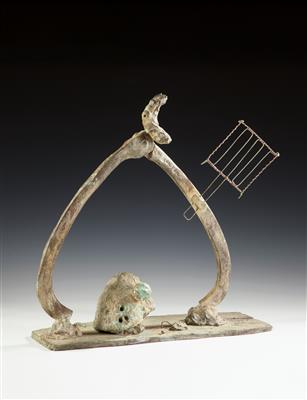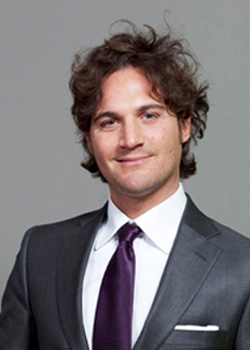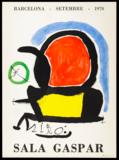Joan Mirò *

(Montroig 1893–1983 Palma de Mallorca)
Oiseau sur une branche (Bird on a branch), 1981, signed and numbered 4/6, bronze with green patina and iron, 82 x 76 x 29,5 cm, Edition of 6 casts signed and justified + 3 nominative copies realized in 1983
Provenance:
Galerie Lelong, Paris (photo certificate available)
European private collection
Exhibited:
Madrid, Mirò Escultor, Centro de Arte Reina Sofia, 21 October 1986–18 January 1987, exh. cat. p. 108, no. 93 with ill. (another example ill.)
Frankfurt a. M., Schirn Kunsthalle, 1988, exh. cat. p. 124, no. 93 with ill. (another example ill.)
Paris, Le rêve interrompu de Mirò, Centre cultural Espanol, Octobe r–December 1988, exh. cat. p. 133, no. 43 with ill. (another example ill.)
Palma de Mallorca, Llonja, Escultures de Mirò, 21 December 1990 – February 1991, exh. cat. pp. 154–155, no. 27 with ill. (another example ill.)
Palma de Mallorca, Lluna Mirò: un segle Pelaires, Centre Cultural Contemporani, April 1993, exh. cat. pp. 48–49 with ill. (another example ill.)
Palma de Mallorca, Poesia a l’espai: Mirò i l’escultura, Fundacio Pilar i Joan Mirò, 30 March – 2 June 1996, p. 187, no. 70 with ill. (another example ill.)
Literature:
E. Fernandez Mirò, P. Ortega Chapel, Joan Mirò. Sculptures. Catalogue raisonné 1928–1982, Daniel Lelong and Successio Mirò, 2006, no. 371 with ill. (another example ill.)
Note:
There are 3 nominatives copies besides the 6 exemplars realized in 1983: one at the Centro Reina Sofia, Madrid; one at the Generalitat of Catalunya and one exemplar at the Fundació Mirò, Barcelona.
“Immobility surprises me. This bottle, this glass, a large pebble on a deserted beach are immovable things, but they trigger great movements in my spirit. I do not feel the same in front of a human being who is constantly moving in an idiotic way. People who go to the beach to bathe and who move affect me much less than the immobility of a stone (immovable things become great, much greater than things that move). Immobility makes me think of great spaces where there are incessant movements that do not stop…”'
Joan Mirò
Traces of worlds that never existed emerge in the works of Joan Mirò. Easy-going but thoughtful, the Catalan master said that emotion moved him and that theory eluded him completely. Melancholic and rebellious, he considered reality to be an accessory to fantasy, so that everything around him was reduced to a superfluous addition. [...] His poetry, in some ways cryptic, was based on the magic of a sign capable of reducing reality to a set of allusions. [...]
The real birth of Mirò as a sculptor, after the almost abstract "constructions" and the "object-sculptures" closer to the surrealists' work, took place in the 1940s during the War, which he spent in solitude and retreat in the Catalan countryside. [...] These primitivist-inspired sculptures are part of a line established or rediscovered by Brancusi and later illustrated by numerous sculptors of whom Arp and Moore are the most eminent representatives. Both, in fact, are contemporaries of Miró. Arp was also a companion of the first discoveries and adventures, [...] they both favoured the automatic association of images of ghosts and a sort of misguided alchemy of which Marcel Duchamp, Mirò's close friend, was the initiator.
Mirò used familiar motifs: a pumpkin, a pebble, a tap, a cactus leaf, a tube of glue, a used bar of soap, a branch, a flask pumpkin, a stump, a prickly pear, a popular toy, a Catalan sweet. For Mirò, the temptation of sculpture was also the desire to get out of his painting studio, to get fresh air and get away, to escape from a rigid series in his essential research.
[...] His old friend Joan Proats says it best: "when I pick up a pebble it is a pebble. When Mirò picks up a pebble it is a Mirò." In response to a question from Deas Swanson asking him if he collected objects Mirò replied: "No, I just use the objects I find: I collect them in my studio which is very big. I put them on the floor in a circle and choose this or that. I assemble several of them and sometimes I reuse elements from other sculptures."
[...] For Mirò, bronze was nothing more than the fossilised memory of an immaterial spark and the action of fire, since sculpture for him was a question posed to the unknown and never the affirmation of knowledge or power.
Franco Basile, in Joan Mirò, ed. Marescalchi, 1997
Expert: Alessandro Rizzi
 Alessandro Rizzi
Alessandro Rizzi
+39-02-303 52 41
alessandro.rizzi@dorotheum.it
30.11.2021 - 18:00
- Odhadní cena:
-
EUR 120.000,- do EUR 160.000,-
Joan Mirò *
(Montroig 1893–1983 Palma de Mallorca)
Oiseau sur une branche (Bird on a branch), 1981, signed and numbered 4/6, bronze with green patina and iron, 82 x 76 x 29,5 cm, Edition of 6 casts signed and justified + 3 nominative copies realized in 1983
Provenance:
Galerie Lelong, Paris (photo certificate available)
European private collection
Exhibited:
Madrid, Mirò Escultor, Centro de Arte Reina Sofia, 21 October 1986–18 January 1987, exh. cat. p. 108, no. 93 with ill. (another example ill.)
Frankfurt a. M., Schirn Kunsthalle, 1988, exh. cat. p. 124, no. 93 with ill. (another example ill.)
Paris, Le rêve interrompu de Mirò, Centre cultural Espanol, Octobe r–December 1988, exh. cat. p. 133, no. 43 with ill. (another example ill.)
Palma de Mallorca, Llonja, Escultures de Mirò, 21 December 1990 – February 1991, exh. cat. pp. 154–155, no. 27 with ill. (another example ill.)
Palma de Mallorca, Lluna Mirò: un segle Pelaires, Centre Cultural Contemporani, April 1993, exh. cat. pp. 48–49 with ill. (another example ill.)
Palma de Mallorca, Poesia a l’espai: Mirò i l’escultura, Fundacio Pilar i Joan Mirò, 30 March – 2 June 1996, p. 187, no. 70 with ill. (another example ill.)
Literature:
E. Fernandez Mirò, P. Ortega Chapel, Joan Mirò. Sculptures. Catalogue raisonné 1928–1982, Daniel Lelong and Successio Mirò, 2006, no. 371 with ill. (another example ill.)
Note:
There are 3 nominatives copies besides the 6 exemplars realized in 1983: one at the Centro Reina Sofia, Madrid; one at the Generalitat of Catalunya and one exemplar at the Fundació Mirò, Barcelona.
“Immobility surprises me. This bottle, this glass, a large pebble on a deserted beach are immovable things, but they trigger great movements in my spirit. I do not feel the same in front of a human being who is constantly moving in an idiotic way. People who go to the beach to bathe and who move affect me much less than the immobility of a stone (immovable things become great, much greater than things that move). Immobility makes me think of great spaces where there are incessant movements that do not stop…”'
Joan Mirò
Traces of worlds that never existed emerge in the works of Joan Mirò. Easy-going but thoughtful, the Catalan master said that emotion moved him and that theory eluded him completely. Melancholic and rebellious, he considered reality to be an accessory to fantasy, so that everything around him was reduced to a superfluous addition. [...] His poetry, in some ways cryptic, was based on the magic of a sign capable of reducing reality to a set of allusions. [...]
The real birth of Mirò as a sculptor, after the almost abstract "constructions" and the "object-sculptures" closer to the surrealists' work, took place in the 1940s during the War, which he spent in solitude and retreat in the Catalan countryside. [...] These primitivist-inspired sculptures are part of a line established or rediscovered by Brancusi and later illustrated by numerous sculptors of whom Arp and Moore are the most eminent representatives. Both, in fact, are contemporaries of Miró. Arp was also a companion of the first discoveries and adventures, [...] they both favoured the automatic association of images of ghosts and a sort of misguided alchemy of which Marcel Duchamp, Mirò's close friend, was the initiator.
Mirò used familiar motifs: a pumpkin, a pebble, a tap, a cactus leaf, a tube of glue, a used bar of soap, a branch, a flask pumpkin, a stump, a prickly pear, a popular toy, a Catalan sweet. For Mirò, the temptation of sculpture was also the desire to get out of his painting studio, to get fresh air and get away, to escape from a rigid series in his essential research.
[...] His old friend Joan Proats says it best: "when I pick up a pebble it is a pebble. When Mirò picks up a pebble it is a Mirò." In response to a question from Deas Swanson asking him if he collected objects Mirò replied: "No, I just use the objects I find: I collect them in my studio which is very big. I put them on the floor in a circle and choose this or that. I assemble several of them and sometimes I reuse elements from other sculptures."
[...] For Mirò, bronze was nothing more than the fossilised memory of an immaterial spark and the action of fire, since sculpture for him was a question posed to the unknown and never the affirmation of knowledge or power.
Franco Basile, in Joan Mirò, ed. Marescalchi, 1997
Expert: Alessandro Rizzi
 Alessandro Rizzi
Alessandro Rizzi
+39-02-303 52 41
alessandro.rizzi@dorotheum.it
|
Horká linka kupujících
Po-Pá: 10.00 - 17.00
kundendienst@dorotheum.at +43 1 515 60 200 |
| Aukce: | Moderní |
| Typ aukce: | Sálová aukce s Live bidding |
| Datum: | 30.11.2021 - 18:00 |
| Místo konání aukce: | Wien | Palais Dorotheum |
| Prohlídka: | Online |
Další objekty umělce
-

Vyvolávací cena:
EUR 300,- -

Vyvolávací cena:
EUR 260,- -

Vyvolávací cena:
EUR 260,-
